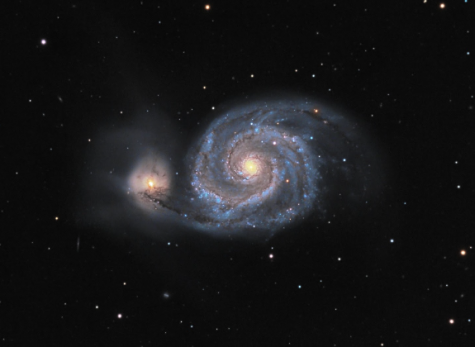This Day in History: October 16, 1773
October 17, 2020

On today’s date in history, in 1773, a French astronomer named Charles Messier looked up into the sky and found the first ever observance of a spiral galaxy, named later as Messier 51 after him. But why is this event important, and does it still have an impact even to this day?
Galaxies and Their Types
In order to know why Messier 51 is so important, we have to learn about the types of galaxies out there. There are six types, Spiral, Barred Spiral, Irregular, Lenticular, Peculiar, and Elliptical. But for the sake of simplification, we’ll focus on the common three: Spiral, Irregular, and Elliptical.
Spiral galaxies, as seen in the image above, is named for the circular or spinning shape it’s outer rings have, which is given the shape because of the gravitational pull of a sun, or sometimes even a black hole. One of the most famous and recognizable of these galaxies is our own Milky Way, which houses the solar system Earth is located in among estimated 400 billion stars.
Irregular galaxies are much different than Spirals, not having exactly one shape or form, either being circles or unidentifiable blobs. It is believed that this is caused when two galaxies collide or merge together, losing most or all of their original shape in the process, creating the very distinct forms they are well known for.
The last type of galaxy is Elliptical, this one being a very odd and intriguing type. It’s form is spherical or oval, but being very smooth on the edges, unlike the circular ones for the Irregular galaxies, as well as having more of a spherical shape than the flat organization of Irregular. They are also very bright, being more discernible than similar galaxies of similar types. The reason the galaxies are like this is because of the black holes located in the centers of every galaxy in the Elliptical category.
Discovery of Messier 51
Not much is known about the first ever discovery of Messier 51, other than it took place today on October 16, 1773, by a French astronomer named Charles Messier, the namesake of the classification all galaxies are given, with a few exceptions. He was mainly known for looking and finding comets to challenge people who studied them, and one day while looking for one to do this task, found Messier 51. His discovery was undocumented, however, since this was the early 1700s, so the first proper record of the galaxy’s appearance was in 1845.
The 1845 appearance was made by William Parsons, otherwise known as the 3rd Earl of Rosse. His was in Birr Castle, Ireland, employing a high-powered 72-inch telescope, which allowed him to view it more clearly than Messier’s view. However, NASA has confirmed that Messier’s viewing was the first instead of Parsons, with it instead being a rediscovery of sorts.
The Impact of Messier’s Discovery
But why was Messier’s discovery so crucial? For starters, it invented a new classification of galaxy, which can be obviously seen as crucial, simplifying the process of identifying a galaxy and making it more accurate. It also is used as a reference point for astronomers, being used as a guide for tributes and properties of what a Spiral galaxy should look like, and what separates it from other galaxy types.
Finally, it’s a major point of interest in both amateur and veteran astronomers alike, with new ones observing it to learn about (as mentioned previously) what galaxies can look like and what their properties are, while for veterans it’s a topic for studying and researching about, one example trying to calculate it’s distance between it and other galaxies seen nearby it, which has been in the process since as early as 2005.
Charles Messier’s observation has been a topic of discussion and interest, as well as being crucial to astrology. As mentioned before, Messier’s effects have benefitted and helped greatly to the causes of astronomy, with the discovery of Messier 51, the Whirlpool Galaxy, being one of his crowning achievements.
Sources:
https://en.wikipedia.org/wiki/Whirlpool_Galaxyhttps://en.wikipedia.org/wiki/Whirlpool_Galaxy
https://en.wikipedia.org/wiki/Elliptical_galaxy#Star_formationhttps://en.wikipedia.org/wiki/Elliptical_galaxy#Star_formation
https://www.nasa.gov/feature/goddard/2017/messier-51-the-whirlpool-galaxyhttps://www.nasa.gov/feature/goddard/2017/messier-51-the-whirlpool-galaxy
href=”https://en.wikipedia.org/wiki/Charles_Messier”>https://en.wikipedia.org/wiki/Charles_Messierhttps://en.wikipedia.org/wiki/Charles_Messier
51/”>https://www.universetoday.com/35997/messier-51/https://www.universetoday.com/35997/messier-51/

